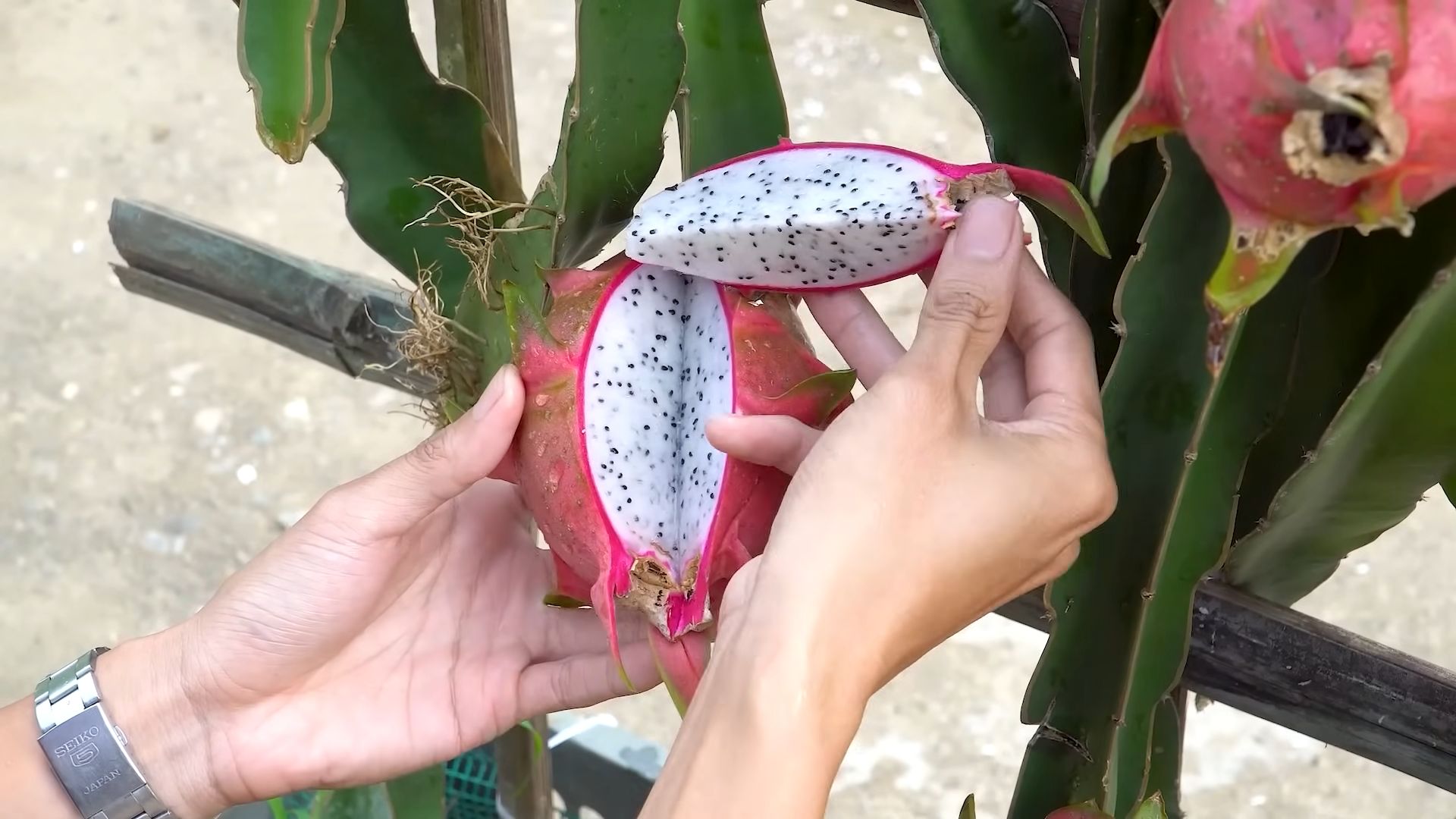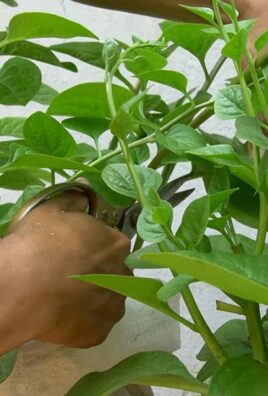Grow Red Dragon Fruit, and transform your backyard into an exotic oasis! Imagine plucking vibrant, magenta-skinned fruit straight from your own garden – a feat that’s surprisingly achievable with the right know-how. For centuries, dragon fruit, also known as pitaya, has been revered in Southeast Asia and Latin America, not just for its striking appearance but also for its delicious, subtly sweet flavor and impressive health benefits.
But why should you bother learning how to grow red dragon fruit yourself? Well, store-bought dragon fruit can be expensive and often lacks the intense flavor of homegrown varieties. Plus, there’s immense satisfaction in nurturing a plant from a small cutting to a fruit-bearing beauty. I’m here to guide you through simple, yet effective DIY tricks and hacks that will empower you to cultivate your own thriving dragon fruit plants, even if you’re a beginner gardener. Forget complicated techniques and expensive equipment; we’ll focus on practical, budget-friendly methods that guarantee success. Get ready to embark on a rewarding gardening adventure and enjoy the sweet taste of your own homegrown dragon fruit!

Growing Red Dragon Fruit at Home: A Comprehensive DIY Guide
Hey there, fellow plant enthusiasts! Ever dreamt of having your own exotic fruit garden? Well, let me tell you, growing Red Dragon Fruit (also known as Pitaya) at home is totally achievable, and it’s incredibly rewarding. I’ve been growing these beauties for a few years now, and I’m excited to share my knowledge with you. This guide will walk you through everything you need to know, from choosing the right cutting to harvesting your first delicious fruit. Let’s get started!
Choosing Your Dragon Fruit Cutting or Seed
Before we dive into the nitty-gritty, let’s talk about where your dragon fruit journey begins. You have two main options: starting from a cutting or starting from seeds.
* Cuttings: This is the faster and more reliable method. You’ll get fruit much sooner (usually within 1-2 years) and you’ll know exactly what kind of fruit you’re getting. Look for healthy, mature cuttings that are at least 12 inches long.
* Seeds: Growing from seed is a fun experiment, but it takes longer (3-5 years to fruit) and the fruit might not be exactly like the parent fruit. If you’re feeling adventurous, go for it! Just be prepared for a longer wait.
Where to Get Cuttings:
* Local Nurseries: Check with your local nurseries. They might carry dragon fruit cuttings or plants.
* Online Retailers: Many online retailers specialize in exotic plants and cuttings. Just make sure you’re buying from a reputable source.
* Friends and Neighbors: If you know someone who already grows dragon fruit, ask if they’d be willing to share a cutting. This is often the best option!
Preparing Your Cutting for Planting
Okay, you’ve got your cutting! Now it’s time to get it ready for planting. This step is crucial for successful rooting.
1. Callousing the Cutting: This is super important! Let the cut end of the cutting dry out and callous over for about 7-10 days. This prevents rot when you plant it. Place the cutting in a dry, shaded area. You’ll notice the cut end forming a hardened layer.
2. Rooting Hormone (Optional): While not essential, dipping the calloused end in rooting hormone can speed up the rooting process. Follow the instructions on the rooting hormone package. I’ve had success both with and without it, so don’t worry if you don’t have any.
Preparing the Soil and Pot
Dragon fruit needs well-draining soil. They’re technically cacti, so they don’t like sitting in soggy soil.
1. Choosing the Right Pot: Select a pot that’s at least 10-12 inches in diameter. This will give the roots plenty of room to grow. Make sure the pot has drainage holes!
2. Creating the Perfect Soil Mix: I like to use a mix of:
* 1/3 Cactus potting mix
* 1/3 Perlite (for drainage)
* 1/3 Compost (for nutrients)
Mix these ingredients thoroughly in a large container.
3. Filling the Pot: Fill the pot with your soil mix, leaving a couple of inches of space at the top.
Planting Your Dragon Fruit Cutting
Now for the exciting part – planting!
1. Making the Hole: Dig a hole in the center of the pot that’s deep enough to bury about 2-3 inches of the calloused end of the cutting.
2. Planting the Cutting: Gently place the cutting in the hole and backfill with soil. Pat the soil down lightly to secure the cutting.
3. Watering: Water the cutting thoroughly after planting. Make sure the water drains out of the bottom of the pot.
Providing Support for Your Dragon Fruit
Dragon fruit are climbing cacti, so they need support to grow properly. This is where a trellis or stake comes in handy.
1. Choosing a Support Structure: You have a few options:
* Trellis: A sturdy trellis is a great option for long-term support.
* Stakes: A strong wooden or metal stake can also work well.
* DIY Structure: Get creative! You can build your own support structure using wood, bamboo, or even repurposed materials.
2. Installing the Support: Place the support structure in the pot, close to the cutting. Make sure it’s firmly planted in the soil.
3. Tying the Cutting: As the dragon fruit grows, gently tie it to the support structure using soft twine or plant ties. Don’t tie it too tightly, as this can damage the stem.
Caring for Your Dragon Fruit Plant
Now that your dragon fruit is planted and supported, it’s time to learn how to care for it.
1. Sunlight: Dragon fruit needs plenty of sunlight – at least 6-8 hours per day. Place your plant in a sunny location, such as a south-facing window or a sunny patio.
2. Watering: Water your dragon fruit regularly, but don’t overwater. Allow the soil to dry out slightly between waterings. During the growing season (spring and summer), you’ll need to water more frequently than during the dormant season (fall and winter). I usually check the soil moisture by sticking my finger about an inch deep. If it feels dry, it’s time to water.
3. Fertilizing: Feed your dragon fruit with a balanced fertilizer every 2-3 months during the growing season. Look for a fertilizer that’s specifically formulated for cacti or succulents. I like to use a diluted liquid fertilizer.
4. Pruning: Pruning is important for shaping your dragon fruit plant and encouraging fruit production. Remove any dead or damaged stems. You can also prune to control the size and shape of the plant. The best time to prune is after the plant has finished fruiting.
5. Pest Control: Dragon fruit are relatively pest-resistant, but they can occasionally be affected by pests such as aphids, mealybugs, and spider mites. Inspect your plant regularly for signs of pests. If you find any, treat them with insecticidal soap or neem oil.
6. Temperature: Dragon fruit thrives in warm temperatures (70-80°F). They can tolerate temperatures as low as 32°F for short periods, but they’re not frost-hardy. If you live in a cold climate, you’ll need to bring your plant indoors during the winter.
Encouraging Flowering and Fruiting
Getting your dragon fruit to flower and fruit is the ultimate goal! Here are a few tips to help you along the way:
1. Maturity: Dragon fruit plants typically need to be at least 1-2 years old before they start flowering.
2. Sunlight: As mentioned earlier, plenty of sunlight is essential for flowering.
3. Watering: Consistent watering is important, but avoid overwatering.
4. Fertilizing: Use a fertilizer that’s high in phosphorus and potassium to encourage flowering.
5. Pollination: Dragon fruit flowers are nocturnal and are typically pollinated by bats and moths. If you don’t have these pollinators in your area, you may need to hand-pollinate the flowers. To hand-pollinate, use a small paintbrush to transfer pollen from the stamen (male part) of one flower to the pistil (female part) of another flower. I usually do this in the evening when the flowers are fully open.
6. Night Light: Dragon fruit are stimulated to flower by short day lengths. If you live in an area with long days, you can trick your plant into flowering by providing it with a few hours of darkness each night. I’ve heard of people using a timer to turn off the lights in the room where their dragon fruit is growing.
Harvesting Your Dragon Fruit
Congratulations! You’ve successfully grown your own dragon fruit. Now it’s time to harvest your delicious reward.
1. Knowing When to Harvest: Dragon fruit are typically ready to harvest about 30-50 days after flowering. The fruit will turn a bright red or pink color (depending on the variety) and the “wings” (the scales on the fruit) will start to dry out and turn brown. The fruit should also feel slightly soft to the touch.
2. Harvesting the Fruit: Use a sharp knife or pruning shears to cut the fruit from the stem. Leave a small piece of the stem attached to the fruit.
3. Storing Your Dragon Fruit: Dragon fruit can be stored in the refrigerator for up to a week.
Troubleshooting Common Problems
Even with the best care, you might encounter some problems along the way. Here are a few common issues and how to address them:
* Yellowing Leaves: This could be a sign of overwatering,

Conclusion
So, there you have it! Growing Red Dragon Fruit at home, while it might seem like a tropical dream, is entirely achievable with this simple yet effective DIY trick. We’ve walked you through the process, highlighting the key steps and providing insights that will significantly increase your chances of success. This isn’t just about planting a cutting and hoping for the best; it’s about creating an optimal environment that mimics the dragon fruit’s natural habitat, fostering healthy growth and, ultimately, rewarding you with delicious, vibrant fruit.
Why is this DIY trick a must-try? Because it empowers you to take control of your food source, reduces your reliance on commercially grown produce (often shipped long distances), and connects you with the natural world in a deeply satisfying way. Imagine the pride and joy of harvesting your own Red Dragon Fruit, knowing that you nurtured it from a simple cutting to a thriving, fruit-bearing plant. The taste of homegrown fruit is simply unparalleled, bursting with freshness and flavor that you won’t find in store-bought varieties.
But the benefits extend beyond just the taste. Growing your own Red Dragon Fruit is also an environmentally friendly choice. You’re reducing your carbon footprint by eliminating transportation costs and minimizing the use of pesticides and herbicides often associated with large-scale agriculture. Plus, you’re creating a beautiful and unique addition to your garden or indoor space.
Looking for variations? Absolutely! Experiment with different types of support structures for your dragon fruit plant. While a sturdy post is a common choice, you could also try using a trellis or even training the plant along a fence. Consider adding companion plants to your garden to attract pollinators and deter pests naturally. Marigolds, basil, and sunflowers are all excellent choices. You can also adjust the soil mix to suit your specific climate and growing conditions. If you live in a particularly humid area, you might want to add more perlite or sand to improve drainage. If you live in a drier climate, you might want to add more peat moss or coconut coir to retain moisture.
Don’t be afraid to experiment with different fertilizers as well. While a balanced fertilizer is a good starting point, you can also try using fertilizers specifically formulated for cacti and succulents. These fertilizers are typically lower in nitrogen and higher in phosphorus and potassium, which are essential for flowering and fruiting.
We encourage you to embrace this DIY project and embark on your own Red Dragon Fruit growing adventure. It’s a rewarding experience that will bring you closer to nature and provide you with delicious, healthy fruit for years to come.
Most importantly, we want to hear about your experiences! Share your successes, your challenges, and your tips with us in the comments section below. Let’s create a community of Red Dragon Fruit enthusiasts who can learn from each other and support each other along the way. Your insights could be invaluable to other aspiring growers. So, grab your cuttings, prepare your soil, and get ready to grow your own Red Dragon Fruit! The journey is just as rewarding as the destination.
Frequently Asked Questions (FAQ)
What is the best time of year to start growing Red Dragon Fruit?
The best time to start growing Red Dragon Fruit is during the spring or early summer. This allows the plant to establish itself and grow strong roots before the onset of colder weather. In warmer climates, you can potentially start growing Red Dragon Fruit year-round, but spring and summer offer the most favorable conditions for initial growth.
How long does it take for a Red Dragon Fruit plant to produce fruit?
Generally, a Red Dragon Fruit plant grown from a cutting will start producing fruit within 1 to 3 years. However, this can vary depending on factors such as the variety of dragon fruit, the growing conditions, and the overall health of the plant. Providing optimal care, including proper watering, fertilization, and sunlight, will help accelerate the fruiting process.
What kind of soil is best for growing Red Dragon Fruit?
Red Dragon Fruit plants thrive in well-draining soil that is rich in organic matter. A slightly acidic to neutral pH (around 6.0 to 7.0) is ideal. A good soil mix can be created by combining equal parts of potting soil, perlite, and compost or well-rotted manure. This combination provides good drainage, aeration, and nutrients for the plant.
How much sunlight does Red Dragon Fruit need?
Red Dragon Fruit plants need plenty of sunlight to thrive and produce fruit. Aim for at least 6-8 hours of direct sunlight per day. In hotter climates, some afternoon shade may be beneficial to prevent sunburn. If growing indoors, place the plant near a sunny window or supplement with grow lights.
How often should I water my Red Dragon Fruit plant?
Water your Red Dragon Fruit plant deeply but infrequently. Allow the soil to dry out slightly between waterings. Overwatering can lead to root rot, which is a common problem for dragon fruit plants. The frequency of watering will depend on factors such as the climate, the soil type, and the size of the pot. In general, water more frequently during the growing season (spring and summer) and less frequently during the dormant season (fall and winter).
What kind of fertilizer should I use for Red Dragon Fruit?
Use a balanced fertilizer with an NPK ratio of 10-10-10 or 20-20-20 during the growing season. You can also use a fertilizer specifically formulated for cacti and succulents. Apply the fertilizer according to the instructions on the package. Avoid over-fertilizing, as this can damage the plant. During the flowering and fruiting stages, you can switch to a fertilizer that is higher in phosphorus and potassium to promote fruit development.
How do I pollinate my Red Dragon Fruit plant?
Red Dragon Fruit flowers are typically nocturnal and rely on bats and moths for pollination. However, if you are growing your plant indoors or in an area with limited pollinators, you may need to hand-pollinate the flowers. Use a small paintbrush to transfer pollen from the stamen (male part) of one flower to the pistil (female part) of another flower. Hand-pollination is best done at night when the flowers are fully open.
What are some common pests and diseases that affect Red Dragon Fruit?
Common pests that can affect Red Dragon Fruit include aphids, mealybugs, and scale insects. These pests can be controlled with insecticidal soap or neem oil. Root rot is a common disease that can occur if the plant is overwatered. To prevent root rot, ensure that the soil is well-draining and avoid overwatering. Other potential diseases include fungal infections, which can be treated with fungicides.
How do I prune my Red Dragon Fruit plant?
Pruning is important for maintaining the shape and health of your Red Dragon Fruit plant. Prune away any dead, damaged, or diseased branches. You can also prune to control the size and shape of the plant. Pruning is best done after the plant has finished fruiting.
Can I grow Red Dragon Fruit indoors?
Yes, you can grow Red Dragon Fruit indoors, but it requires providing the plant with adequate sunlight and proper care. Place the plant near a sunny window or supplement with grow lights. Ensure that the pot has good drainage and use a well-draining soil mix. Water the plant regularly, but avoid overwatering. Hand-pollination may be necessary if there are limited pollinators indoors.




Leave a Comment